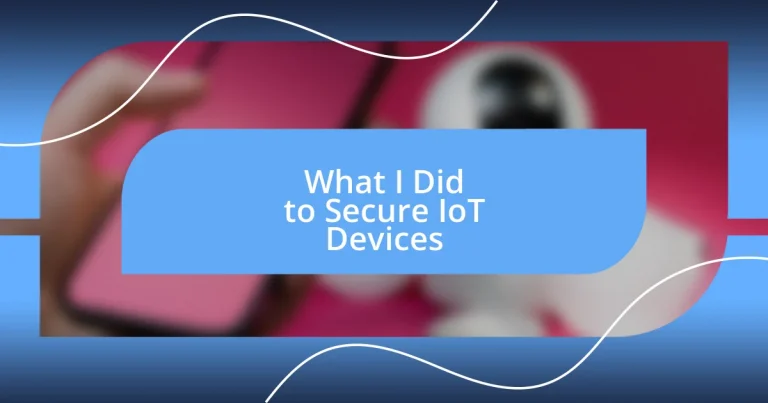Key takeaways:
- Identifying vulnerable IoT devices is crucial; check for default passwords, update firmware, scan for open ports, and monitor data traffic.
- Implementing strong password practices, such as using unique passwords for each device and considering a password manager, significantly enhances security.
- Educating users about IoT security risks fosters community awareness and empowers individuals to take proactive measures to protect their devices.
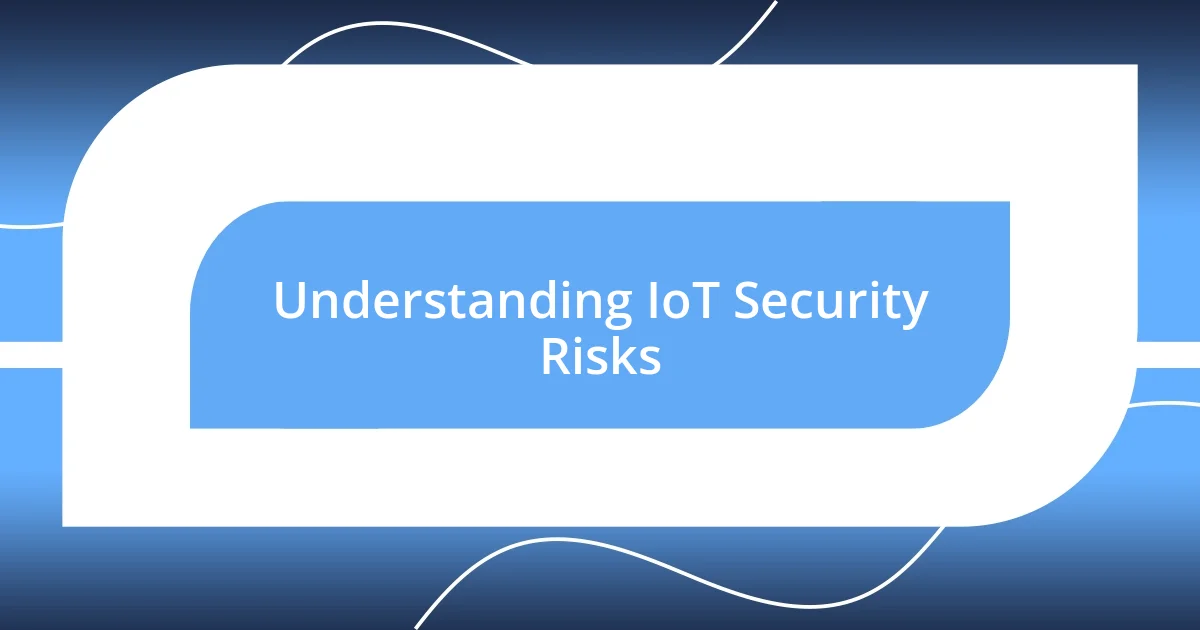
Understanding IoT Security Risks
When I first started integrating IoT devices into my home, I felt a mix of excitement and anxiety. The convenience was undeniable, but I couldn’t shake the feeling that each smart gadget could be a potential entry point for cyber threats. Have you ever considered how deeply interconnected these devices are, and how one vulnerability can lead to a cascading effect on your entire network?
One of the most surprising risks I encountered was the lack of proper authentication features on many devices. For instance, I was shocked to learn that some of my smart cameras were using default passwords that anyone could easily guess. This realization prompted me to think about how many users might overlook such basic security measures, leaving themselves unnecessarily exposed.
As I dove deeper into understanding IoT security, I discovered that many devices collect and share vast amounts of personal data. This raised a red flag for me—what happens if that data falls into the wrong hands? Reflecting on the potential implications, I realized that securing my IoT devices was not just about protecting gadgets; it was about safeguarding my privacy and peace of mind.
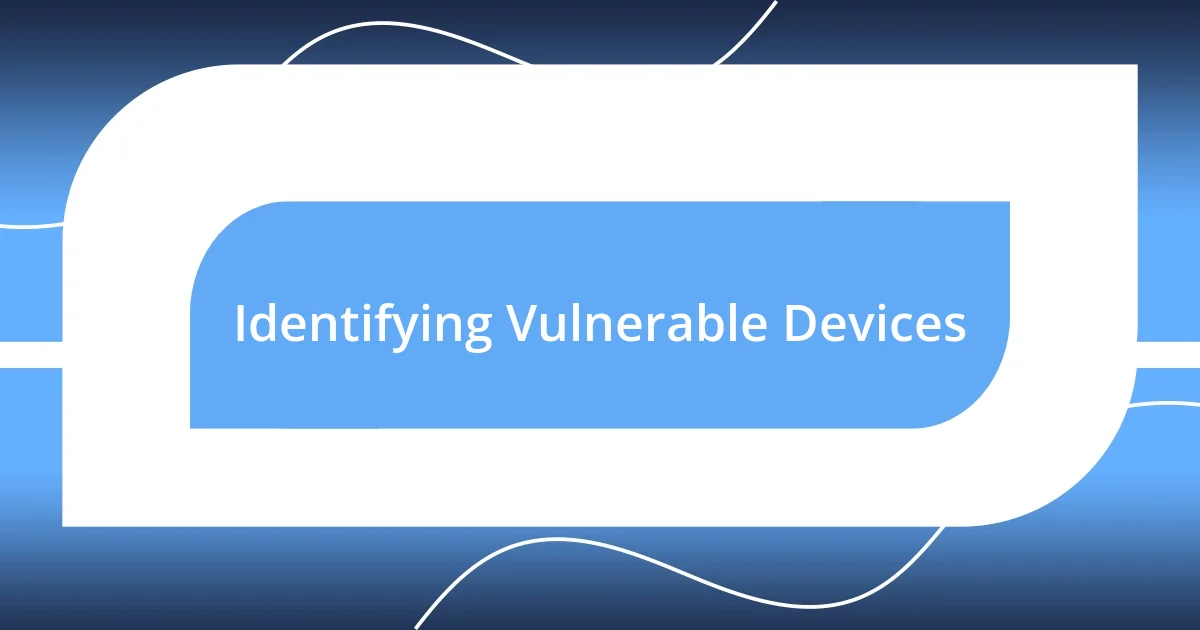
Identifying Vulnerable Devices
Identifying vulnerable devices in my home network turned out to be a significant eye-opener. I began by scanning my network for connected devices, quickly realizing that some quirky gadgets I had nearly forgotten about were still live. Each one of these devices presents its unique set of vulnerabilities, often hinging on outdated firmware or weak security protocols.
To help you pinpoint these potential threats, consider the following checklist:
- Check for Default Passwords: Many devices come with factory-set passwords that are easy to find online.
- Look for Firmware Updates: Ensure that all devices are running the latest firmware to patch known vulnerabilities.
- Scan for Open Ports: Use network scanning tools to identify any open ports that shouldn’t be accessible.
- Monitor Data Traffic: Track unusual data traffic to and from devices—you might uncover hidden vulnerabilities.
- Review Device Settings: Regularly audit settings to ensure that security features, like encryption, are enabled.
Upon going through this process, I felt a mix of relief and alarm. I discovered a few devices that had never been updated since I purchased them! It was a stark reminder that regular oversight is crucial in this rapidly evolving digital landscape.
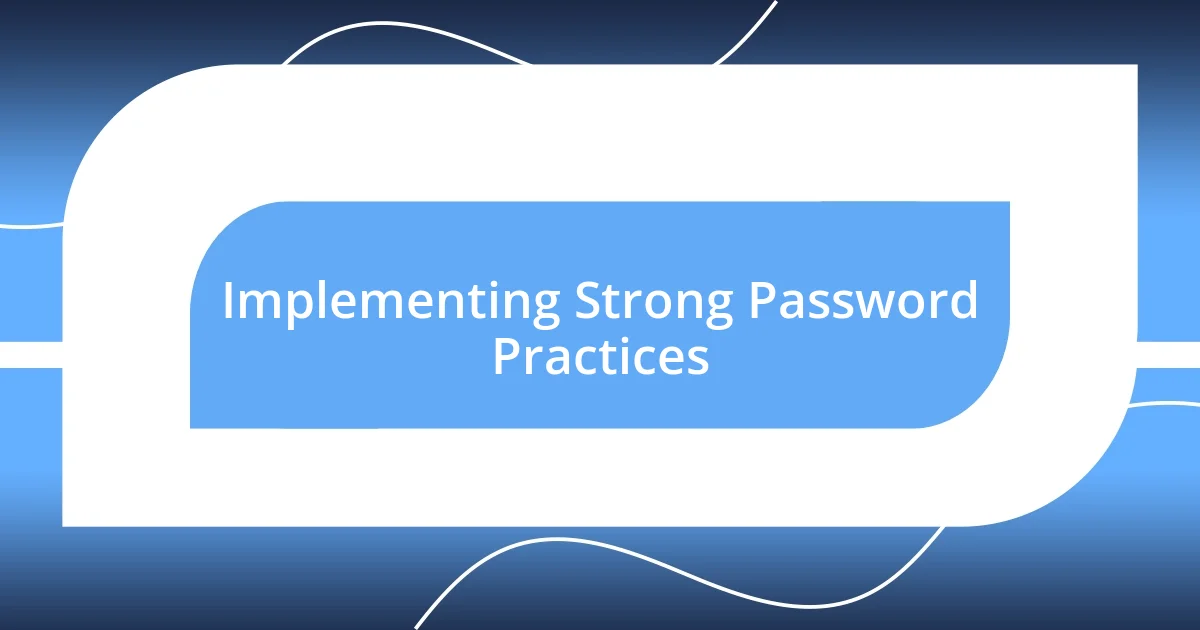
Implementing Strong Password Practices
Implementing strong password practices can feel like a daunting task, but it’s one of the most pivotal steps I took in securing my IoT devices. Initially, I used a single password across multiple devices, which seems practical until you acknowledge the risk it poses. When I finally decided to create unique passwords for each device, I felt a newfound sense of security. It’s not just about complexity; having diverse passwords minimizes the impact if one device were to be compromised.
In my experience, I found that using a password manager simplified this challenge significantly. I never thought I’d be someone who relies on technology for remembering my passwords, but now it feels like second nature. The added layer of encryption the manager provides gives me peace of mind. You might also want to consider incorporating special characters or passphrases—these not only enhance security but are often easier to remember than random letters and numbers.
To emphasize just how different these practices are from using the same weak passwords, I’ve compiled a comparison table showcasing weak versus strong password strategies.
| Weak Password Practices | Strong Password Practices |
|---|---|
| Using default passwords | Creating custom passwords for each device |
| Reusing passwords across multiple devices | Employing a password manager to track unique passwords |
| Simple passwords (e.g., “123456”, “password”) | Complex passwords with character variety |
| Ignoring password updates | Regularly updating passwords |
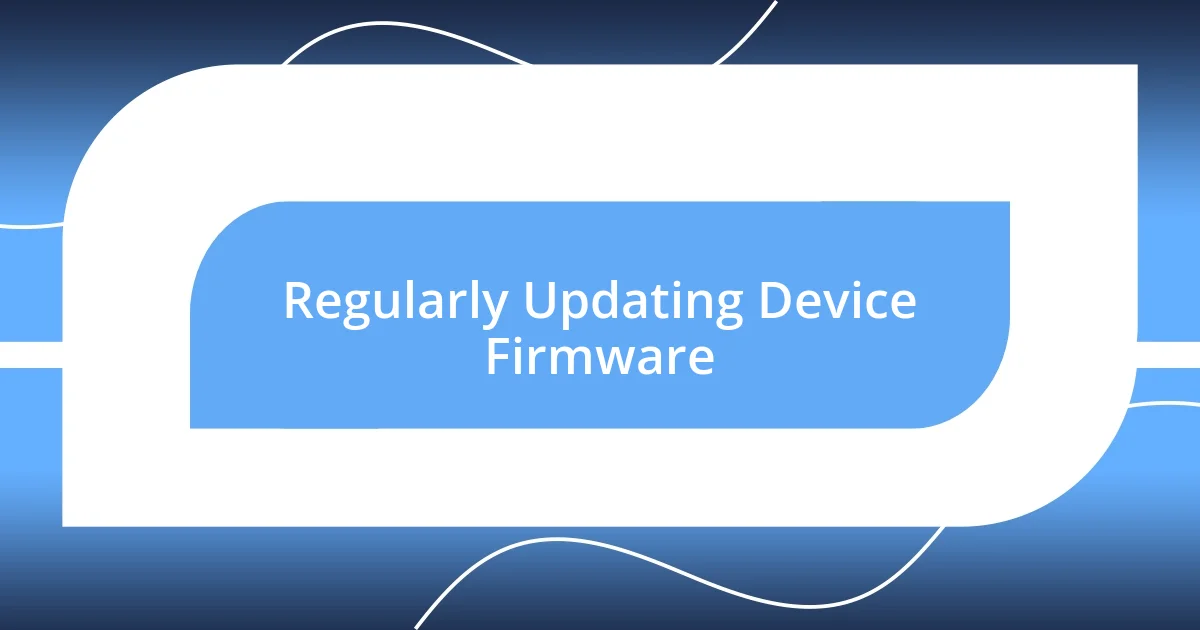
Regularly Updating Device Firmware
Regularly updating device firmware is a crucial part of keeping my IoT devices secure. I still remember the day I clicked on an update button and felt that rush of anxiety mixed with excitement. Would it work without issues? As it turns out, staying current with firmware updates has proven to be one of my most effective strategies against security vulnerabilities. Each update often includes patches for known exploits, making those seemingly simple updates my first line of defense.
There was a time when I neglected these updates, thinking my devices were “smart enough” to fend for themselves. I’ve learned the hard way that this complacency can be dangerous. Once, I discovered that one of my security cameras had a vulnerability that was publicly exploited, and I rushed to update the firmware while feeling my heart race. That experience drove home the importance of making it a habit to check for updates regularly. I now set reminders on my calendar, treating firmware updates like essential appointments—because they are.
As you might wonder about the ease of updating these devices, I can assure you that many manufacturers offer seamless ways to handle this. Some devices even allow for automatic updates, which I’ve embraced wholeheartedly. Have you ever felt that sense of accomplishment when you’ve completed a task that protects your home? That’s precisely how I feel every time I ensure my devices are running on the latest firmware. It’s a small act, but it carries immense peace of mind, knowing I’m doing my part to safeguard my digital space.

Utilizing Network Segmentation Strategies
Network segmentation strategies have been a game changer in my pursuit of securing IoT devices. By dividing my home network into distinct segments, I was able to contain potential breaches and prevent them from spreading to my more sensitive devices. Imagine having your smart thermostat isolated from your security cameras; it gives me a sense of relief, knowing that even if one device is compromised, others remain protected.
I remember the first time I set up a separate network for my IoT devices. It felt a bit like partitioning my home; suddenly, there was a newfound sense of control. I could monitor each segment’s traffic without feeling overwhelmed. This isn’t just a technical task—it’s about taking physical spaces and replicating that structure digitally. I often ask myself, “What would happen if an attacker found their way in?” Segmenting my networks has made this question less daunting, as I know my core devices remain isolated from any potential threats lurking in those less secure corners.
Utilizing network segmentation isn’t just about security; it also streamlines the management of devices. I find that troubleshooting a specific section is much easier, allowing me to resolve issues without impacting other devices. Have you ever faced a situation where a problematic IoT device brought your entire setup to a halt? Trust me, that’s an experience I wouldn’t wish on anyone. By organizing my network, I’ve created a digital ecosystem that feels manageable and secure, bringing both peace of mind and efficiency into my home.
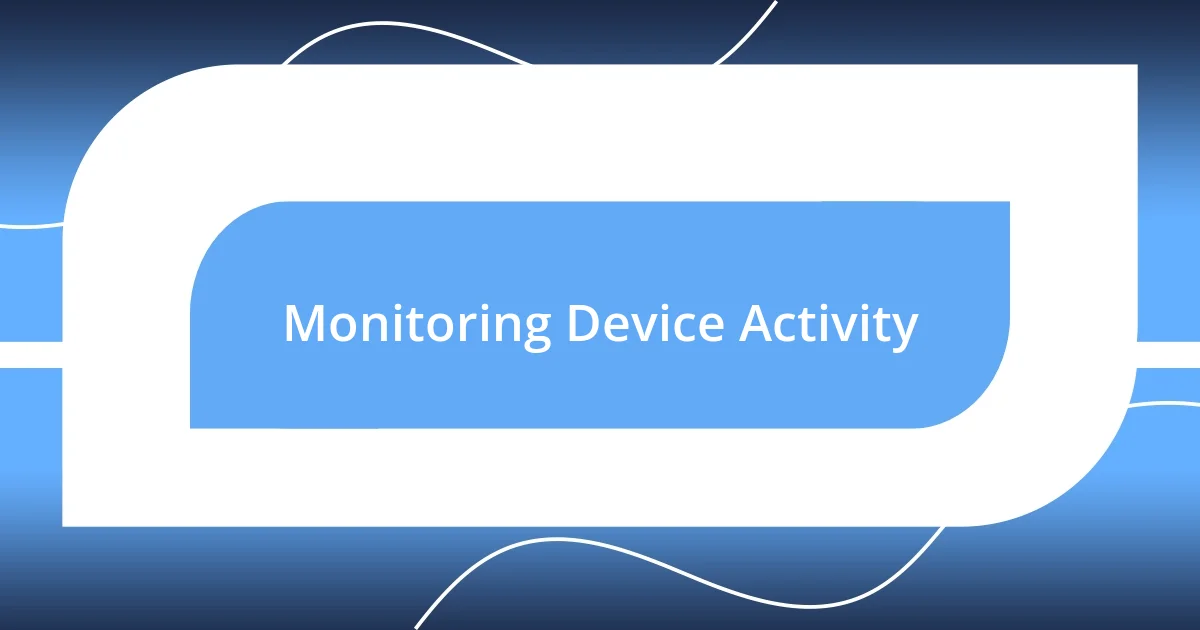
Monitoring Device Activity
Monitoring device activity has become one of my top priorities in maintaining the security of my IoT ecosystem. I remember the first time I noticed unusual activity on one of my smart plugs; it lit up at odd hours. Initially, I brushed it off as a glitch, but upon further investigation, I realized someone might have accessed it without my knowledge. That experience taught me the value of vigilance. By setting up alerts for any irregular activity, I can stay informed and act quickly if something feels off.
I’ve found that monitoring tools make this process significantly easier. Some devices come with built-in monitoring options, which I thought would be a hassle to configure. To my surprise, many offer user-friendly apps that provide real-time updates. Using these apps, I can track when devices are being used and even create schedules for when they should be inactive. It feels almost like having a digital babysitter, ensuring everything operates within the norms I set. Isn’t it incredible how technology can give us that kind of control?
Reflecting on my journey, I recall the relief I felt after investing time into setting up device monitoring. One night, I noticed my smart camera flashing a notification about unusual movement. Instead of panicking, I checked my monitoring app and discovered it was only a stray cat. That moment highlighted something vital: having the right tools allows me to respond calmly to potential threats. It’s like possessing a safety net, providing comfort in an otherwise uncertain world. Wouldn’t you agree that peace of mind is invaluable?
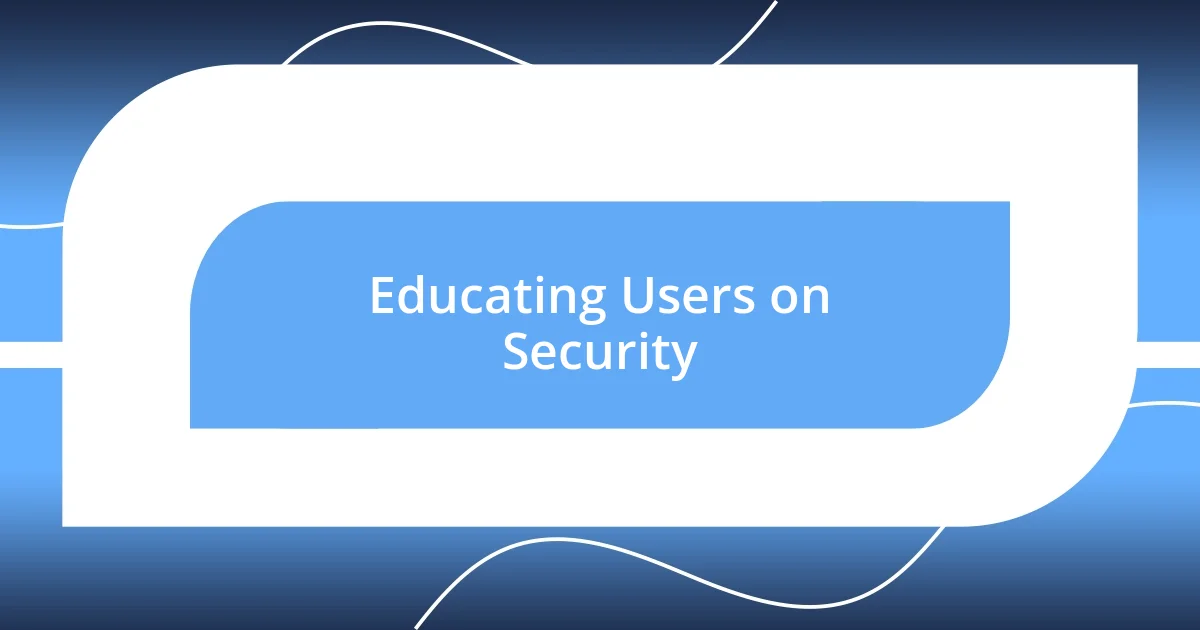
Educating Users on Security
Educating users about security is critical in today’s IoT landscape. Early on, I realized that many people—my friends included—were unaware of the basic security risks associated with their devices. I remember explaining to a friend why it was essential to change default passwords. When I saw the lightbulb moment in their eyes, it reinforced my belief that sharing knowledge can empower individuals to take control of their security.
Additionally, I often host informal gatherings where I discuss these topics. It can be challenging to strike the right balance between being informative and not overwhelming others with too much detail. I’ve found using relatable analogies helps; for instance, comparing a weak password to leaving your front door unlocked is a concrete way for others to grasp the importance of creating strong defenses. Have you ever thought about how something as simple as a password can be the difference between safety and a breach? Engaging in these conversations has left me feeling more connected to my community, knowing we’re all better off together.
One of my more eye-opening experiences was helping a neighbor secure their smart home devices. They had a smart doorbell that could be easily accessed with just a factory setting password. It felt alarming! Together, we updated the password and reviewed privacy settings, turning a daunting task into a collaborative effort. Seeing their newfound confidence reminded me that education fosters security confidence—one conversation at a time, we can create a more secure digital environment.












